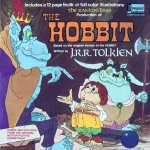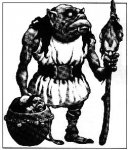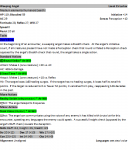Southern Oracle
Explorer
Like many gamers my age, my first exposure to the horror genre in D&D was Ravenloft the module. Written by Tracy and Laura Hickman, it stands the test of time because of the rich backstory, the well-developed characters, and the salute to classic archetypes. Count Strahd von Zarovich and the lands of Barovia became such icons that they inspired the Ravenloft campaign setting, where horror flourished within an ingenious framework that allowed different campaign settings, adventure styles, and themes to reside side-by-side without diluting their impact.
Although I love the Ravenloft module, my favorite Ravenloft adventure has always been Feast of Goblyns. Setting aside the evocative setting of Kartakass and the village of Harmonia, as well as compelling villains like Harkon Lukas, Radaga, and Dr. Dominiani, it’s the titular creatures that have always captured my imagination. I think they’re scary, and I go out of my way to make them feel scary whenever I run the module.
Looking back, the goblyns remind me a lot of the goblins from the Rankin/Bass production of The Hobbit. Those huge mouths, fangs, and large eyes were terrifying when I was little, and the Ravenloft version is very similar in appearance. Plus, the goblyns from Feast of Goblyns have a terrifying ability called “feasting.” They eat your face – literally. They grab your throat with both hands and stick your head in their mouths and chew. Besides the damage you expect, you also take suffocation damage if you fail a saving throw (this is back in Advanced Dungeon & Dragons days). And for every 10 points of damage you take, you suffer a permanent -1 penalty to your Charisma, representing the horrible wounds and resulting scars, should you live.
Plus, the goblyns from Feast of Goblyns have a terrifying ability called “feasting.” They eat your face – literally. They grab your throat with both hands and stick your head in their mouths and chew. Besides the damage you expect, you also take suffocation damage if you fail a saving throw (this is back in Advanced Dungeon & Dragons days). And for every 10 points of damage you take, you suffer a permanent -1 penalty to your Charisma, representing the horrible wounds and resulting scars, should you live.
If you’re the DM for your group and you’ve been together for a while, you get a feel for what creeps your players out. In the Age of Worms adventure “The Whispering Cairn,” there’s a teenaged ghost that haunts an area the characters need to access. Alastair Land died of a broken neck, and his visage reflects it in gory detail. For someone with kids, it’s a disturbing image, and I’m glad Paizo provided art for full impact.
In the Planescape adventure The Great Modron March, Doctor Valran Stonefist experiments on humanoids by replacing their body parts with pieces from kidnapped modrons. Since modrons are technically immortal and return to Mechanus when they die, he needed to keep them alive for the transplanted parts to remain functional for his experiments. The scene of maimed, mewling modrons scattered about in metal cages is unsettling, but I chose to take it a step further.
Two of the characters in that game are married – Pasha and Lucius Varrelialus, a druid and paladin, respectively. Instead of having Valran perform his heinous operations on an NPC, I had him kidnap and experiment on Pasha. Seeing his wife splayed on an operating table with her severed legs in a basket made Lucius mad with grief and, after the party defeated Valran’s forces (the doctor escaped), he fell comatose. Pasha was eventually restored to her former self by a wish spell, but Lucius never recovered. To this day he resides in the Gatehouse in Sigil, cared for by members of the Bleak Cabal. From time to time Pasha visits him, and she sometimes talks to the patient in the cell next door, Gifad (a link to the Planescape adventure Faction War).
 In the Age of Worms adventure “A Gathering of Winds,” the final battle is against an oculus demon. Augerric’s body is covered with eyes, even on his wings. Since my group for that game is so large, I thought Augerric needed some company, something that complemented his all-seeing nature. When the party entered the chamber, they saw the demon, and they noticed four statues standing in the corners of the room, hands covering their faces. Every so often, when the characters were preoccupied, the statues would move, but never if they were directly looked at.
In the Age of Worms adventure “A Gathering of Winds,” the final battle is against an oculus demon. Augerric’s body is covered with eyes, even on his wings. Since my group for that game is so large, I thought Augerric needed some company, something that complemented his all-seeing nature. When the party entered the chamber, they saw the demon, and they noticed four statues standing in the corners of the room, hands covering their faces. Every so often, when the characters were preoccupied, the statues would move, but never if they were directly looked at.
If you’re a fan of Doctor Who, you know what I just described. The weeping angels are considered one of the more terrifying of the Whovian villains to the public at large, let alone my wife and daughters. When the characters figured out what was happening, a slugfest turned into a tactical dance where everyone tried to keep an angel in sight whilst simultaneously trying to avoid Augerric’s gaze attacks. To add insult to injury, when Tara, my daughter Faelyn’s weaponmaster, used her daily power Ride the Giant Down on the oculus demon, I described his eyeballs squishing and popping as Tara clung to his scaly hide and clambered on his back – she was suitably grossed out.
If you don’t know what will give your players nightmares, undead are a good place to start. And if you want to give the characters nightmares as well, I heartily recommend the despair deck from the Shadowfell: Gloomwrought and Beyond supplement for 4E D&D. A simple jaunt through the Shadowfell to save time on a journey landed the characters in a battle with shadar-kai, nightmares, and oblivion wraiths, and all but one ended up with a despair card that affected them for the rest of the session. The cards are a great roleplaying tool, as well as having mechanical disadvantages (and advantages, when you overcome them).
Unfortunately, I have to work on Halloween night, so I can’t run a suitably themed game in honor of the holiday, but I hope some of you can. What horrific visions have you conjured up for your players, or what are you planning to do that’s gaming related for Halloween? Have you ever creeped out a player, or has a player roleplayed a horrified character? Let me know in the comments below.
Happy Halloween!
Although I love the Ravenloft module, my favorite Ravenloft adventure has always been Feast of Goblyns. Setting aside the evocative setting of Kartakass and the village of Harmonia, as well as compelling villains like Harkon Lukas, Radaga, and Dr. Dominiani, it’s the titular creatures that have always captured my imagination. I think they’re scary, and I go out of my way to make them feel scary whenever I run the module.
Looking back, the goblyns remind me a lot of the goblins from the Rankin/Bass production of The Hobbit. Those huge mouths, fangs, and large eyes were terrifying when I was little, and the Ravenloft version is very similar in appearance.
If you’re the DM for your group and you’ve been together for a while, you get a feel for what creeps your players out. In the Age of Worms adventure “The Whispering Cairn,” there’s a teenaged ghost that haunts an area the characters need to access. Alastair Land died of a broken neck, and his visage reflects it in gory detail. For someone with kids, it’s a disturbing image, and I’m glad Paizo provided art for full impact.
In the Planescape adventure The Great Modron March, Doctor Valran Stonefist experiments on humanoids by replacing their body parts with pieces from kidnapped modrons. Since modrons are technically immortal and return to Mechanus when they die, he needed to keep them alive for the transplanted parts to remain functional for his experiments. The scene of maimed, mewling modrons scattered about in metal cages is unsettling, but I chose to take it a step further.
Two of the characters in that game are married – Pasha and Lucius Varrelialus, a druid and paladin, respectively. Instead of having Valran perform his heinous operations on an NPC, I had him kidnap and experiment on Pasha. Seeing his wife splayed on an operating table with her severed legs in a basket made Lucius mad with grief and, after the party defeated Valran’s forces (the doctor escaped), he fell comatose. Pasha was eventually restored to her former self by a wish spell, but Lucius never recovered. To this day he resides in the Gatehouse in Sigil, cared for by members of the Bleak Cabal. From time to time Pasha visits him, and she sometimes talks to the patient in the cell next door, Gifad (a link to the Planescape adventure Faction War).
If you’re a fan of Doctor Who, you know what I just described. The weeping angels are considered one of the more terrifying of the Whovian villains to the public at large, let alone my wife and daughters. When the characters figured out what was happening, a slugfest turned into a tactical dance where everyone tried to keep an angel in sight whilst simultaneously trying to avoid Augerric’s gaze attacks. To add insult to injury, when Tara, my daughter Faelyn’s weaponmaster, used her daily power Ride the Giant Down on the oculus demon, I described his eyeballs squishing and popping as Tara clung to his scaly hide and clambered on his back – she was suitably grossed out.
If you don’t know what will give your players nightmares, undead are a good place to start. And if you want to give the characters nightmares as well, I heartily recommend the despair deck from the Shadowfell: Gloomwrought and Beyond supplement for 4E D&D. A simple jaunt through the Shadowfell to save time on a journey landed the characters in a battle with shadar-kai, nightmares, and oblivion wraiths, and all but one ended up with a despair card that affected them for the rest of the session. The cards are a great roleplaying tool, as well as having mechanical disadvantages (and advantages, when you overcome them).
Unfortunately, I have to work on Halloween night, so I can’t run a suitably themed game in honor of the holiday, but I hope some of you can. What horrific visions have you conjured up for your players, or what are you planning to do that’s gaming related for Halloween? Have you ever creeped out a player, or has a player roleplayed a horrified character? Let me know in the comments below.
Happy Halloween!
Attachments
Last edited by a moderator:



